1. Introduction
This document summarizes the instructions and guidelines for the proper use of the Muse v3 system. The Muse v3 system is a multi-sensor embedded platform with Bluetooth communication capabilities. A 3D render of the platform is shown in Figure 1, alongside the reference system that the system uses for any inertial and orientation data.
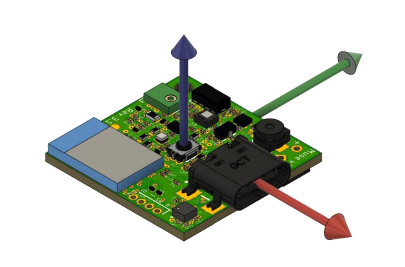
FIGURE 1: 3D RENDER OF THE MUSE V3 PLATFORM AND ITS REFERENCE SYSTEM. X IN RED, Y IN GREEN AND Z IN BLUE.
The MuSe v3 possesses various means of direct interaction, highlighted in Figure 2; a brief description is as follows:
- Push button: it can be used to start or stop a log operation (see 5.5). For the sake of simplicity, this document will refer to it simply as “the button”.
- RGB led: it will be used by the system to indicate currently ongoing operations. For the sake of simplicity, this document will refer to it as “the LED”, specifying which of the three colors is of interest (e.g. “the red LED will light up during…”, “the green LED will start blinking..”)
- Magnetic buzzer: it will be used by the system to indicate specific events.
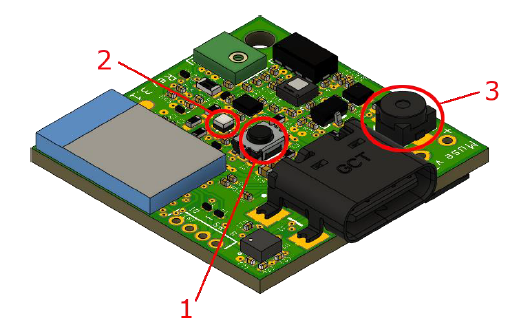
FIGURE 2: MUSE V3 USER INTERACTION CAPABILITIES
2. Requirements and setup
Apart from the MuSe v3 system itself, the following items are needed in order to properly operate the system:
- Laptop/PC running Windows 8 or later.
- At least one mean of communication with the system, between
- One USB type-A to USB-type C cable
- A Bluetooth compatible PC
The software can be installed using the provided installer, by following the procedure highlighted by the wizard. Once the installation is complete, the user should find the software under the name “MuseV3 Viewer”.
3. Terminology and system states
The MuSe v3 system provides various modes of operation, highlighted in this section. The user should be aware of the terminology regarding the button usage; the system differentiates between a button short and long push:
- A short push is defined as pressing the button for more than 0.5 s but less than 1 s
- A long push is defined as pressing the button for more than 2 s but less than 5 s
3.1 Idle – Awaiting for commands
The simplest mode of operation for the MuSe v3 system is the idle condition: when in this state, the system will await for commands from the user. This document will refer to this mode simply as “idle” (e.g. “when the system is idle”).
3.2 Log – Logging data to memory
This mode of operation will see the MuSe v3 platform extracting data from the selected sensors, then saving it into a file in memory. Refer to 5.6 for more information about how to enter this mode. This document will refer to this mode as “log” or “logging” (e.g. “in order to start a log…”, “when the system is logging data…”)
3.3 Streaming – Streaming data to Bluetooth
Very similarly to the log mode of operation, the streaming will gather data from selected sensors, to then transmit it directly via Bluetooth, without saving it in the onboard memory. Refer to 5.7 for more information about how to enter this mode. This document will refer to this mode as “stream” or “streaming” (e.g. “in order to stream data…”, “when the system is streaming”).
3.4 Readout – Reading a file from memory
Once the system has completed a log operation, a file will be available in memory. Depending on the log type (user selected sensors and data sampling frequency), the process of downloading the file to the user’s PC can be lengthy. During this process the system is said to be in readout mode. Refer to 5.8 for more information about how to enter this mode. This document will refer to this mode as “readout” or “download” (e.g. “when the system is in readout”, “in order to download a file…”).
3.5 Standby – Power saving mode
If the system is not performing any of the operations mentioned so far, it will enter a power saving mode in order to increase battery lifetime. The standby mode will be entered if the user presses the button for more than 2 seconds or, alternatively, if the system remains idle for more than 30 seconds. The user should note that the system cannot enter the standby mode if any of these conditions is met:
- The Bluetooth connection is active. The user should disconnect the Bluetooth to allow the system to enter standby.
- The USB is connected
- A log or a streaming operation is ongoing
- A memory erase operation is ongoing
This document will refer to this mode as “standby” (e.g. “when the system is in standby”). In order to exit this mode, the user should perform a long button press (see 3) or connect the USB. Additionally, the user should note that no LED pattern is enacted while in standby.
4. LED patterns
This section will list the various led patterns that the user can experience during the usage of the MuSe v3 platform. As an introduction, the user should be aware of the terminology used in the following paragraphs:
- Breath(s)/breathing: referred to the LEDs, a single “breath” corresponds to the LED ramping up the light intensity gradually, then ramping it down at the same rate. Breathing refers to the repetition of said pattern.
- Blip: referred to the LEDs, a single blip is a brief flash of the LED, with the duration of 0.1s. Usually this pattern will be accompanied by the period of repetition (e.g. “the green LED will blip once every 6 seconds”, “the system will perform one blip of the red LED every second”).
The user should also be aware that the MuSe v3 system has two exceptions to the LED patterns that are described in the following chapters:
- Once the system exits standby, it will report the battery by lighting the LED (for a duration of 3 seconds) green if the battery is above 50%, yellow if the battery is between 50% and 20% or red if the battery is below 20%.
- The system will report the start and stop of a log or streaming operation by lighting the LED (for a duration of 3 seconds) green or red, respectively.
4.1 Idle
The MuSe v3 system will signal its idle condition by performing a blip of the blue LED every second.

Beware that without further interaction, the system will automatically enter standby after 30 seconds, terminating the just described pattern. Refer to 3.5 for more information about the standby mode.
4.2 Stand-by
In standby, the MuSe v3 system will not enact any LED pattern.
4.3 Charging
The MuSe v3 system will signal an ongoing recharge by performing a blip of the yellow LED every second.

4.4 Log
The MusSe v3 system will signal the log mode by performing one blip of the blue LED every 6 seconds.

4.5 Streaming
The MuSe v3 system will signal the streaming mode by performing one blip of the green LED every 6 seconds.

4.6 Readout
The MuSe v3 system will signal its readout mode by lighting the green LED for the entire duration of the process.

4.7 Memory erase
As the log memory is being erased, the MuSe v3 system will perform a blip of the red LED once every second.

5. MuSe V3 Software
In the following sections, a summary of the main functionalities of the MuSe v3 software is reported.
5.1 Initialization
In order to establish a Bluetooth communication with the MuSe v3 system, the following steps must be performed.
NOTE: Do not connect the MuSe via the PC’s built-in Bluetooth.
1. Make sure that the Bluetooth connection is active
2. Click on the “Search” button to start a Bluetooth scan. A MuSe v3 system will appear in the listed devices
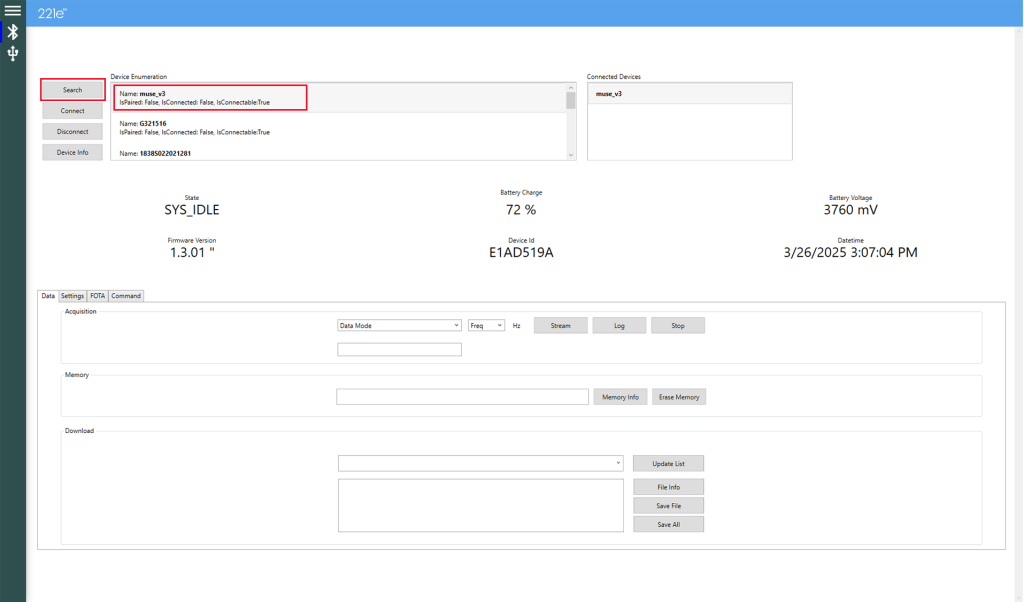
3. Select the MuSe_v3 system from the “Device enumeration” list and press connect. The system will appear in the list ofconnected devices on the right.
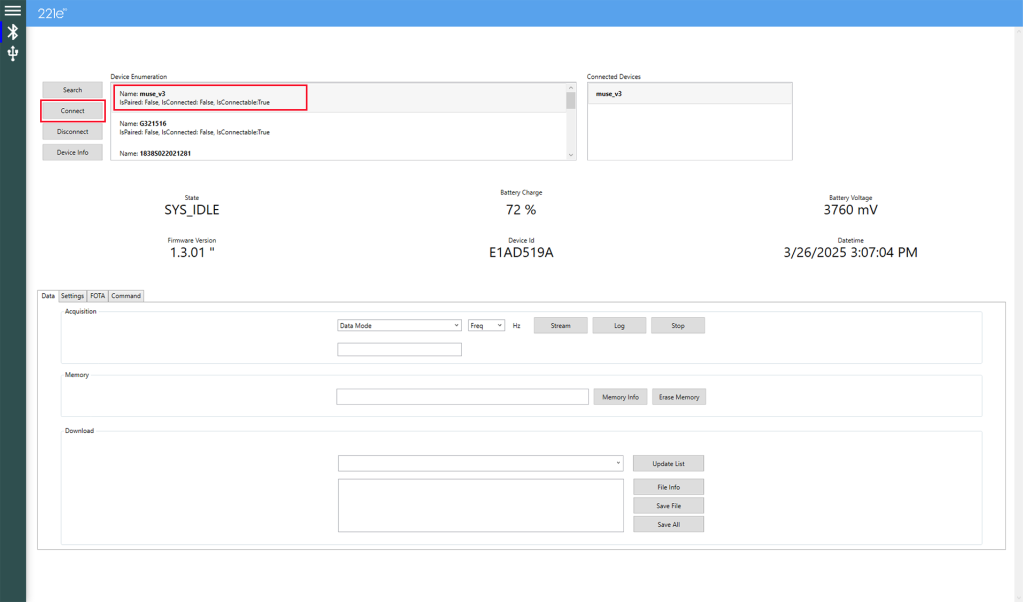
4.Once connected, the software will update the basic device information tab, containing the system state, the bootloader and firmware versions, the battery charge and voltage, the device ID and the currently set device date.
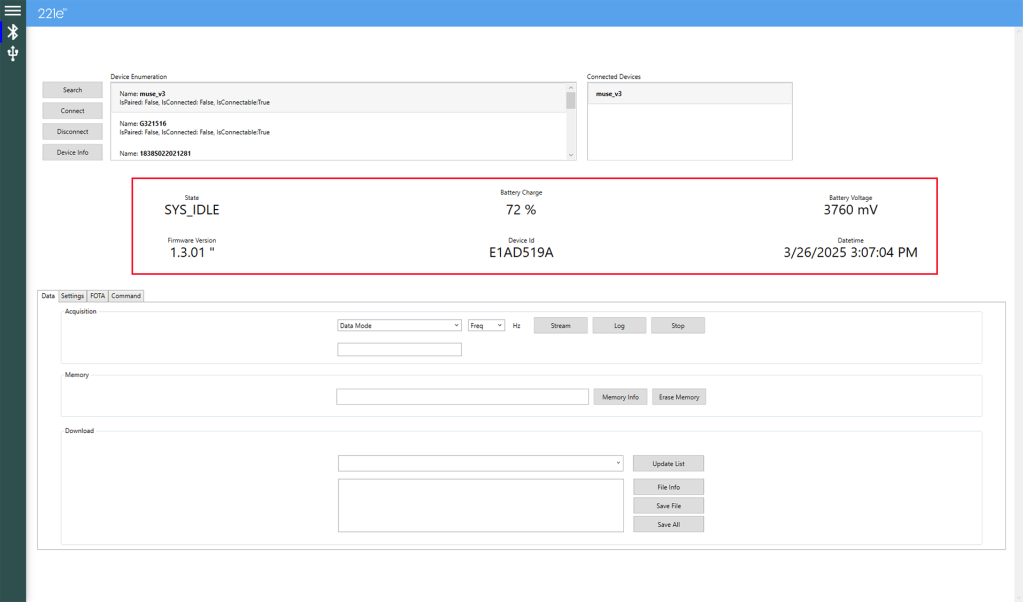
5.2 Firmware update
The firmware update process is needed whenever a new firmware needs to be installed on the MuSe v3 system. In order to install a new firmware, the system must be restarted in the so-called boot loader mode:
1.Open the MuSe v3 software and establish a connection to the system (refer to 5.1 for the complete procedure).
2.Select the “FOTA” operations tab

3.Select “Bootloader mode” on the center part of the screen and press the restart button
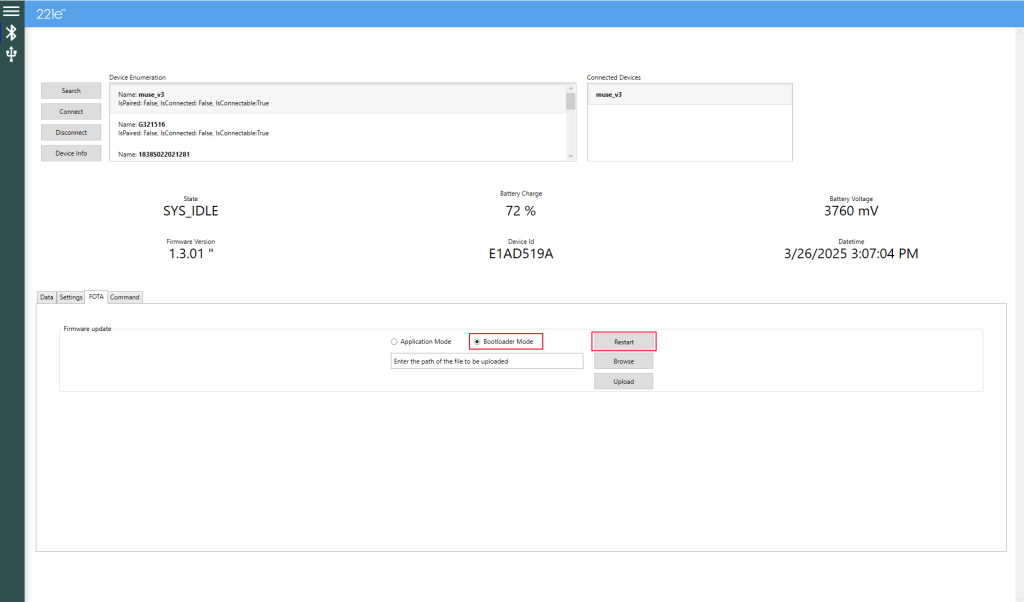
4. If the process of restarting the sensor in boot loader mode succeeds, the blue led will start breathing.
5. The user should reset the connection and scan for the device again, using the procedure highlighted in 5.1.
6. The user shall now select the new firmware to upload using the “browse” button on the bottom right.
7. The selected firmware can be uploaded with the “upload” button. The led will light up blue, then green. The software will report a progress count, followed by “UPDATE COMPLETE” at the end of the operation.

8. The user should wait for the operation completion, signified by the appearance of the “UPDATE COMPLETE” message. If successful, the system will restart in the idle state, identifiable by the blue LED performing one blip per second.
9. The user should reset the connection and perform a new scan and re-connection, as highlighted in 5.1.
5.3 Time configuration
It may be useful to have the time of the system updated, in such a way that log outputs can be monitored systematically. In order to set the time, please establish a connection with the system (refer to 5.1) and perform the following steps:
- Click on the “Settings” operation tab
- Click on the “Set Date/Time” button in order update the time set on the device.
- The time shown in the basic device information tab should be updated now
NOTE: the time set is UTC.
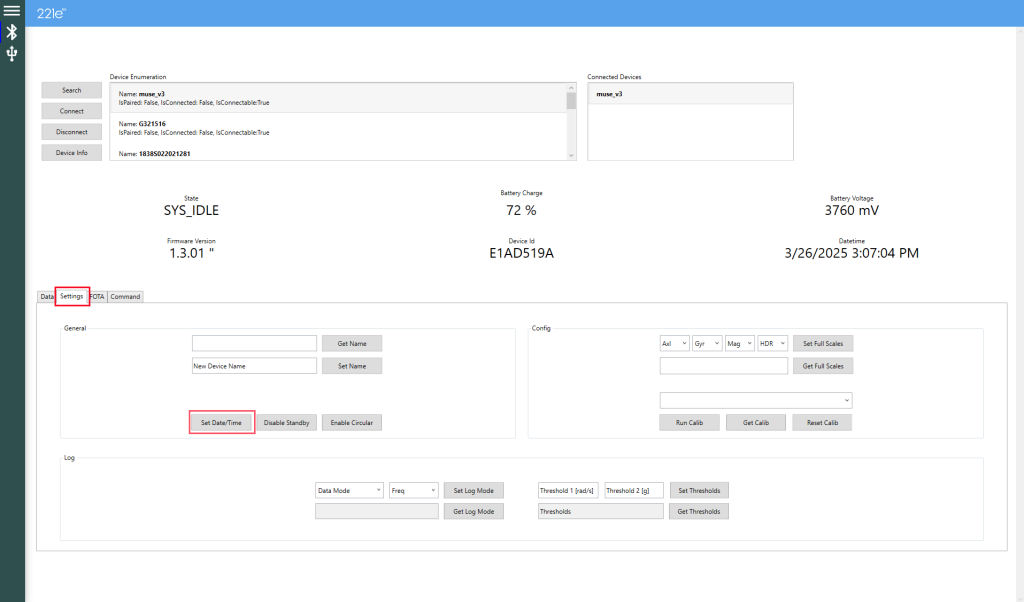
5.4 Device name configuration
It may be useful to assign a custom name to the MuSe v3 system for easier identification during operation. To set the device name, follow the steps below:
- Click on the “Settings” operation tab
- Click on the “Set Name” button and enter the desired name
- To verify that the operation was successful, click on the “Get Name” button
NOTE: The device name must contain the string “muse”, and it is recommended to avoid spaces in the name.
5.5 Sensors full scale
The full scale of the sensors can be configured from the configuration page. The following full scales can be configured:
- Accelerometer: ±4g, ±8g, ±16g, ±32g
- Gyroscope: ±245dps, ±500dps, ±1000dps, ±2000dps
- High dynamic range accelerometer: ±100g, ±200g, ±400g
- Magnetometer: ±4G, ±8G, ±12G, ±16G
To do so, the following steps shall be performed:
- Establish a connection to the system
- Click on the “Settings” operation tab
- Select the desired full scale from the related dropdown lists on the right.
- Press the “Set Full Scales” button.
NOTE: this will not effect ongoing log or streaming modes. The system should be idle when setting the new full-scales.
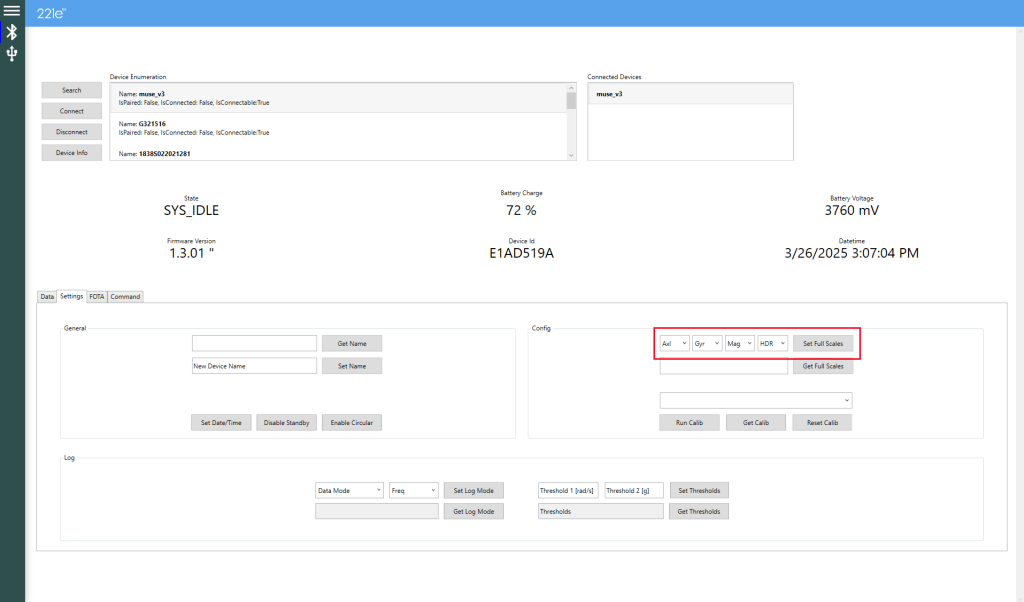
5.6 Button log configuration
The system can be configured so that a short (0.5s) press of the button will start a predefined log configuration. The following steps are needed in order to configure the button log mode:
- Establish a connection to the system
- Navigate to the “Settings” operation tab
- Desired log mode and frequency from the bottom center selection.
- Press the “Set Log Mode” button.
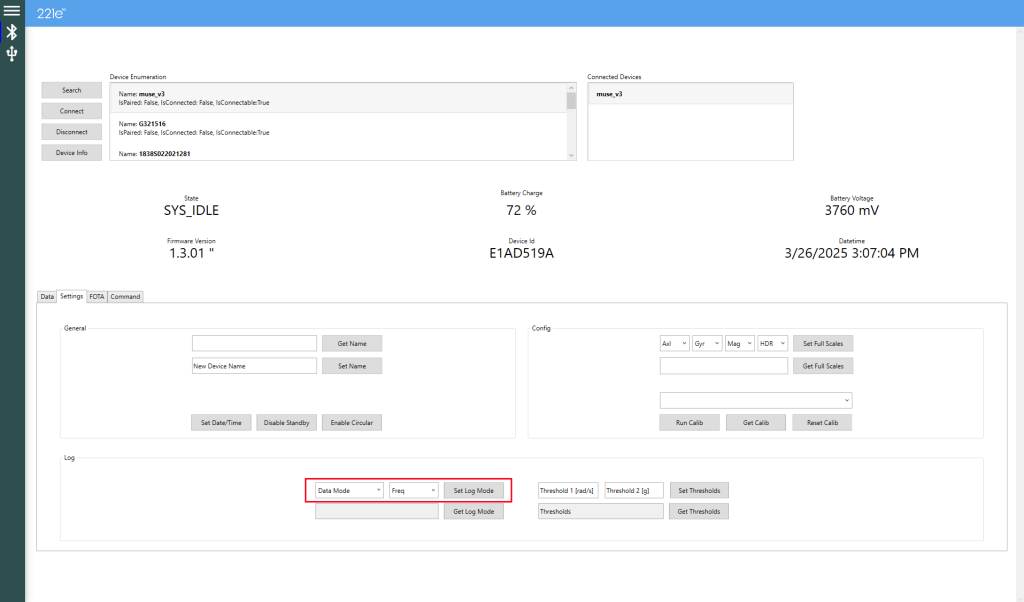
The user configuration is saved in non-volatile memory and remains valid even after a full battery discharge. Reconfiguration is only necessary if changes to the setup are required.
5.7 Start and stop a log file
The software can be used to start and stop a log session by means of the following steps:
- Establish a connection to the system.
- Navigate to the “Data” operation tab
- Select the desired frequency from the dropdown list in the “Acquisition” group box.
- Press on the “Log” button in the “Acquisition” group box.
- The system will now enter the log mode, and its LED pattern should change accordingly. See 4.4 for details.
To stop a log session, click on the “Stop” button within the “Acquisition” group box. The system will return in the idle mode, and LED pattern should change accordingly. See 4.1 for details.

Alternatively, the data log can be started by a short press of the button (see 3) after setting the desired mode and frequency (refer to 5.5 for more information). The data log can be stopped with another short button push.
The two start/stop procedures can be combined: a log can be started via the software and stopped via the button, and vice versa. The user should note that starting the log procedure via the button will always set the mode and frequency to the one set with the procedure highlighted in 5.5, regardless of any other log started using the software, using the procedure highlighted in this section.
5.8 Start and stop streaming data
The software can be used to start and stop the streaming of data. Streamed data will appear in the graph above the “Acquisition” group box. In order to start a data stream, the user should follow these steps:
- Establish a connection to the system.
- Navigate to the “Data” operation tab
- Select the desired frequency from the dropdown list in the “Acquisition” group box.
- Press on the “Stream” button in the “Acquisition” group box.
- The system will now enter the streaming mode, and its LED pattern should change accordingly. See 4.5 for details.
To stop a data streaming session, click on the “Stop” button within the “Acquisition” group box. The system will return in the idle mode, and LED pattern should change accordingly. See 4.1 for details.
5.9 File Download
5.9.1 Download via Bluetooth
In order to download a file, the user should select the file from the dropdown list and press the read file button. The procedure in details entails:
- Establish a connection to the system
- Navigate to the Data operation tab
- Navigate to the dropdown menu on the bottom part of the screen and select the desired file. The user should note that the system will report the correct date and time on the files only if the time has been previously set (as per the procedure highlighted in 5.3).
- The file information, such as starting time and date, mode, frequency and fullscales can be obtained by pressing the File Info button.
- The file can be downloaded by pressing the Save file button. The user will be prompted with a selection for the folder and file name.
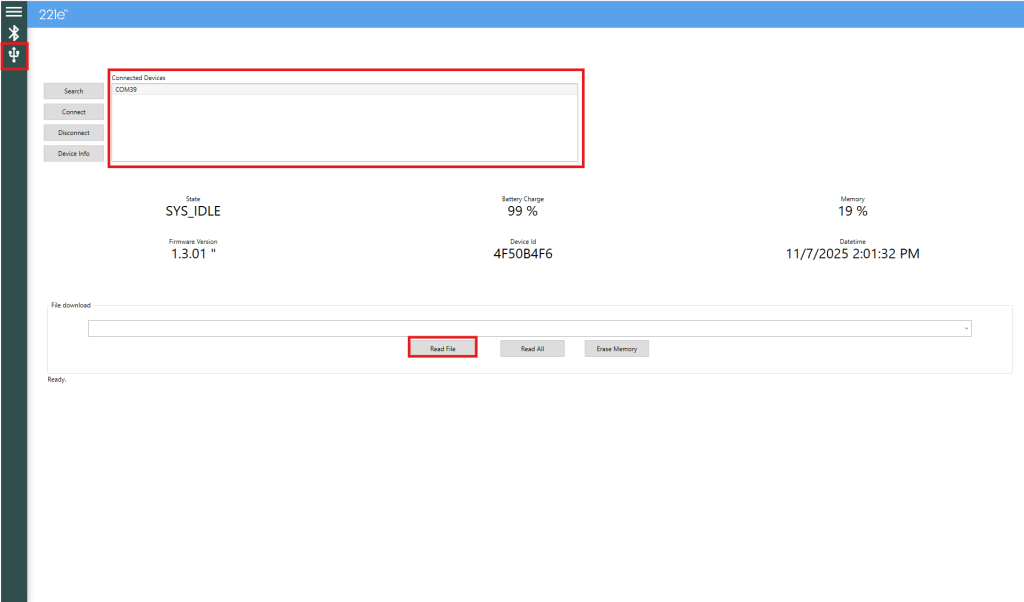
5.9.2 Download via USB-C
To download a file via USB, the procedure is slightly different from Bluetooth download. The steps are as follows:
- Connect the device to the PC using a USB-C data cable
- Open MuseViewer and double-click the USB symbol at the top left
- A new screen, slightly different from the previous one, will appear
- Click Search; in the adjacent box, the names of the COM ports to which the devices are connected will appear. Select the one corresponding to the Muse from which you want to download data
- Once the port is selected, click Connect
- After connecting, the file download procedure is similar to Bluetooth: open the dropdown menu in File Download, select the desired file, and click Read File
- Once the download is complete, the user will be prompted to select the folder and file name.
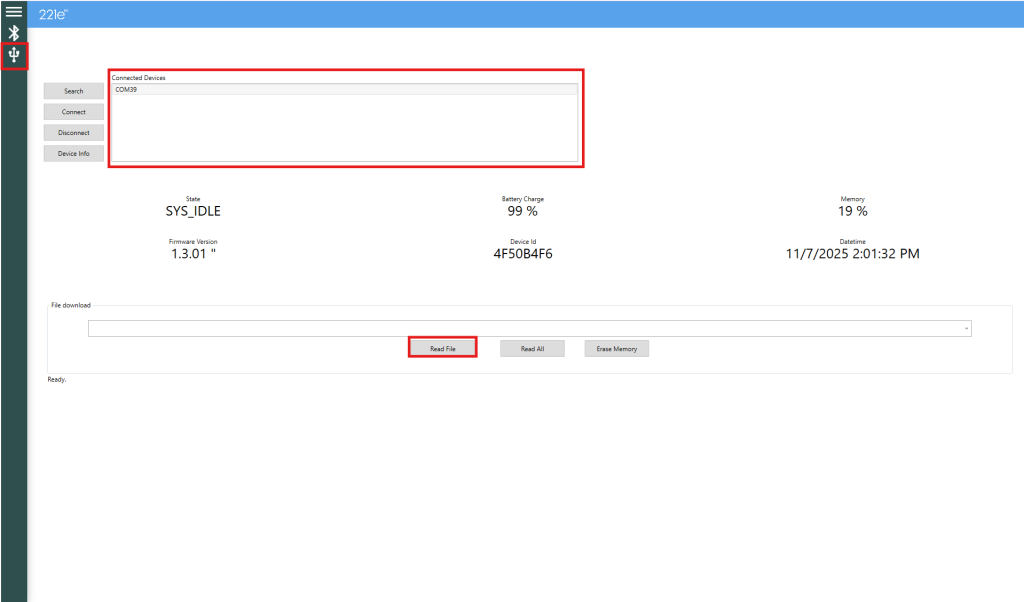
5.10 Memory Erase
The memory can be erased by means of the following steps:
- Establish a connection to the system.
- Navigate to the “Data” operation tab
- Press on the “Erase Memory” button on the bottom right part of the screen.
- A confirmation prompt will appear asking for user input. Choosing “All” will erase the entire memory, choosing “written” will only delete the written part of the memory. A full erase is suggested.
- The LED will change pattern accordingly, as described in Section 4.7.
- Please wait the completion of the operation before continuing. The duration can vary depending on the memory used so far, and can last up to 5 seconds. Refer to the LED pattern to know the operation status.
6. Endurance
| Condition | Power cons. [mA] |
Battery duration [h] |
Autonomy [day] |
Memory duration [h] |
|---|---|---|---|---|
| Standby | 0.0024 | 45000.0 | 1875 | n.a. |
| Idle | 2.464 | 44.5 | 1.9 | n.a. |
| Log IMU+MAGN+HDR @25 Hz | 4.744 | 23.2 | 1 | 61.9 |
| Log IMU+MAGN+HDR @1600 Hz | 4.779 | 23.0 | 1 | 1 |
| Stream IMU+MAGN+HDR @25 Hz | 3.306 | 33.2 | 1.4 | n.a. |
| Stream IMU+MAGN+HDR @100 Hz | 3.399 | 32.4 | 1.3 | n.a. |
| Readout | n.a. |
TABLE 1: SUMMARY OF THE POWER CONSUMPTION OF THE MUSE V3 SYSTEM IN THE DIFFERENT MODES OF OPERATION, ALONG WITH THE RELATED MEMORY DURATION (WHEN APPLICABLE).
7. Appendix
7.1 Muse external connector
7.1.1 Expansion connector
The muse v3 system is able to connect to an external expansion board via a 20-pin board-to-board Slimstack connector by Molex, 559091674. A scheme of the available buses/GPIOs present on the connector on the Muse v3 side is depicted in Figure 3. The connector features a UART, an SPI and an I2C bus, plus two dedicated interrupts. All unused buses pins can be used as GPIOs.
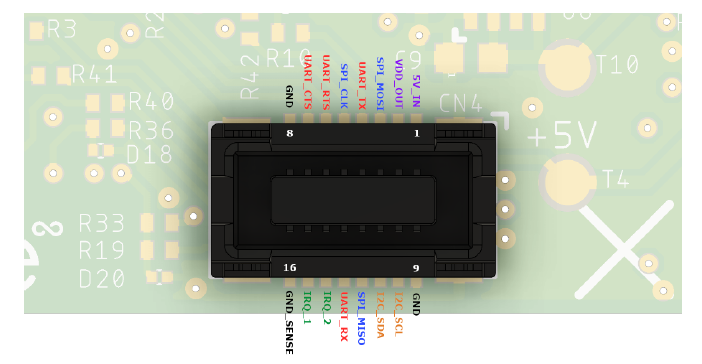
FIGURE 3: SLIMSTACK CONNECTOR ON THE MUSE V3 SYSTEM
Magnetic distortions (e.g., proximity to metal objects or electromagnetic fields) can affect the accuracy of the heading estimation.
Muse is supplied with the following default configuration and previously calibrated (i.e., gyroscope and accelerometer). However, it is always recommended to perform a calibration of the magnetometer to setup the overall system to the environmental conditions of use.
| Pin # | Name | Description |
|---|---|---|
| 1 | 5V_IN | 5V supply to power the muse device. Peak current ~50 mA. |
| 2 | VDD_OUT | 2.9V output powered by the muse internal rail. |
| 3 | SPI_MOSI | MOSI line for the SPI bus. |
| 4 | UART_TX | TX line for the UART serial. |
| 5 | SPI_CLK | Clock line for the SPI bus. |
| 6 | UART_RTS | RTS line for the UART serial. |
| 7 | UART_CTS | CTS line for the UART serial |
| 8 | GND | Ground |
| 9 | GND | Ground |
| 10 | I2C_SCL | SCL line for the I2C bus. |
| 11 | I2C_SDA | SDA line for the I2C bus. |
| 12 | SPI_MISO | MISO line for the SPI bus. |
| 13 | UART_RX | RX line for the UART serial. |
| 14 | IRQ_2 | Interrupt input 2. |
| 15 | IRQ_1/ADC | Interrupt input 1 / ADC input. |
| 16 | GND_SENSE | Ground sense. Used by the muse to detect a connected board. Internally pulled up to VDD. |
To customize Muse settings run Muse viewer software application and connect the device.